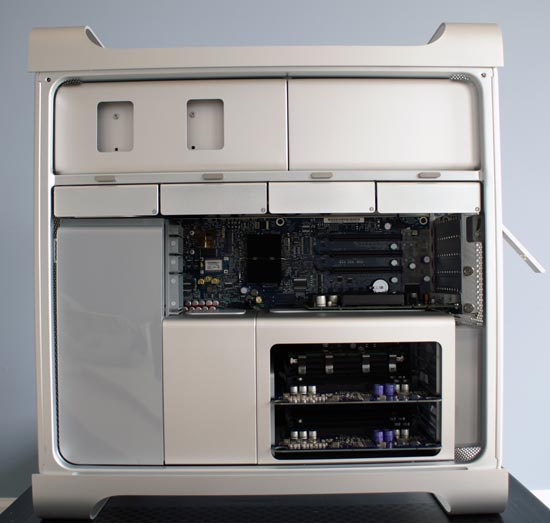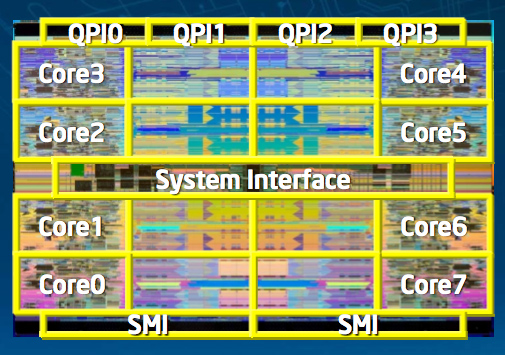Upgrading and Analyzing Apple's Nehalem Mac Pro
by Anand Lal Shimpi on July 13, 2009 5:00 PM EST- Posted in
- Mac
In my line of work, I tend to get access to a lot of very fast hardware. Both our SSD and GPU testbeds use Intel’s new Core i7 processor. If you read my review of the i7 you may have left the review feeling slightly underwhelmed by the processor. Sure, it was fast, but it wasn’t that much faster than a speedy Core 2 Quad.
In the months since that review went live I’ve had the benefit of using the i7 a lot. And I might’ve grown a little attached. The processor itself isn’t overly expensive, it’s the motherboard that really puts it over the top; but if you have the means, I highly recommend picking one up.
This is my Mac Pro:

It may look modern, but this is actually the same Mac Pro I reviewed back in 2006. In it are the same two 3.0GHz dual-core Woodcrest based Xeons that I upgraded it with for part 3 of my Mac Pro coverage. Woodcrest was the server version of Conroe, the heart of the original Core 2 Duo.
You’ll remember that I was quite happy with Conroe when it launched in 2006, so by extension I was quite happy with my Mac Pro. That was then, this is now.
Apple released a newer Mac Pro with quad-core Clovertown parts (65nm Kentsfield equivalent), then once more with Harpertown (45nm Penryn equivalent). While you could stick Clovertown into the first generation Mac Pros, you couldn’t upgrade them to Harpertown without hardware modifications to the system (don’t ask me what they are :)..).
I stayed away from the Harpertown upgrade simply because it was a lot of money for a moderate increase in performance. My desktop tests showed that Penryn generally yielded a 0 - 10% performance increase over Conroe and I wasn’t about to spend $3K for 10%. Steve didn’t need another Benz that badly.
I found myself waiting for Apple to do the right thing and release a Mac based on the Core i7. Surely Apple wouldn’t wait and make a Xeon version, after all why would you need two processors? A single Core i7 can work on eight threads at the same time - most users have a tough time stressing four. Then reality set in: Apple wouldn’t put a Core i7 in the Mac Pro because Dell can do the same in a system for under $900. In order to justify the price point of the Mac Pro, it must use Xeons.
The Nehalem Xeons can be pretty fun. At the high end there’s the Nehalem-EX, that’s 8 cores on a single die. Apple could put two of those on a motherboard and have a 16-core, 32-thread monster that would probably cost over $8,000.

The 8-core Nehalem EX
Getting back to reality, we have the Nehalem-EP processor: effectively a server-version of Core i7. The other major change between Nehalem-EP and Core i7 is that each Nehalem-EP processor has two QPI links instead of one. Nehalem-EP can thus be used in dual-socket motherboards.
Nehalem-EP even uses the same socket as Intel’s Core i7: LGA-1366, implying that Intel artificially restricts its desktop Core i7s to operate in single-socket mode only. Boo.
Of course Nehalem-EP is sold under the Xeon brand; the product names and specs are as follows:
| CPU | Max Sockets | Clock Speed | Cores / Threads | QPI Speed | L3 Cache | Max Turbo (4C/3C/2C/1C) | TDP | Price |
| Intel Xeon W5580 | 2 | 3.20GHz | 4 / 8 | 6.4 GT/s | 8MB | 1/1/1/2 | 130W | $1600 |
| Intel Xeon X5570 | 2 | 2.93GHz | 4 / 8 | 6.4 GT/s | 8MB | 2/2/3/3 | 95W | $1386 |
| Intel Xeon X5560 | 2 | 2.80GHz | 4 / 8 | 6.4 GT/s | 8MB | 2/2/3/3 | 95W | $1172 |
| Intel Xeon X5550 | 2 | 2.66GHz | 4 / 8 | 6.4 GT/s | 8MB | 2/2/3/3 | 95W | $958 |
| Intel Xeon E5540 | 2 | 2.53GHz | 4 / 8 | 5.86 GT/s | 8MB | 1/1/2/2 | 80W | $744 |
| Intel Xeon E5530 | 2 | 2.40GHz | 4 / 8 | 5.86 GT/s | 8MB | 1/1/2/2 | 80W | $530 |
| Intel Xeon E5520 | 2 | 2.26GHz | 4 / 8 | 5.86 GT/s | 8MB | 1/1/2/2 | 80W | $373 |
| Intel Xeon W3570 | 1 | 3.20GHz | 4 / 8 | 6.4 GT/s | 8MB | 1/1/1/2 | 130W | $999 |
| Intel Xeon W3540 | 1 | 2.93GHz | 4 / 8 | 4.8 GT/s | 8MB | 1/1/1/2 | 130W | $562 |
| Intel Xeon W3520 | 1 | 2.66GHz | 4 / 8 | 4.8 GT/s | 8MB | 1/1/1/2 | 130W | $284 |
While Nehalem was originally supposed to have a simultaneous desktop and server/workstation release, the Xeon parts got pushed back due to OEM validation delays from what I heard. Core i7 launched last November and it was now mid-March with no Nehalem based Macs.
I couldn’t wait any longer and I ended up building a Hackintosh based on Intel’s Core i7. Literally a day after I got it up and running, Apple announced the new Nehalem-EP based Mac Pro.










58 Comments
View All Comments
mfago - Monday, July 13, 2009 - link
Apple lists the Mac Pro as supporting DDR3 1066 only, yet the higher speed CPUs should support 1333. Have you tested this? I have an application that would love faster memory.Secondly, while Apple's prices are much higher than previous models (due to Intel's CPU prices, as you note), have you compared similar machines from Dell/HP? _Significantly_ more expensive: a T5500 with 2x2.93 GHz and 12 GB ram is $8000 (before discounts). Otherwise, the only way to get decent prices is through second/third tier vendors, or building one yourself. Sure CPU/RAM upgrades have always been this way, but Intel's extreme prices on Nehalem make this very obvious.
austin512 - Saturday, May 1, 2010 - link
Hi Anand,Any word on if the W3680 will work in the 2009 Mac Pro?
rominator - Thursday, July 22, 2010 - link
"While you could stick Clovertown into the first generation Mac Pros, you couldn’t upgrade them to Harpertown without hardware modifications to the system (don’t ask me what they are :)..)."AFAIK, nobody has ever discussed being able to do this. ANyone have an idea what he's referring to?
mrob27 - Thursday, September 23, 2010 - link
Upgrading CPUs:I have the 2.26 GHz 8-core model. I cannot afford to take the risk, but I'd love to upgrade it someday if it was less risky.
I think you should carefully measure the thickness of Xeon processors with and without the heat spreader (using an outside micrometer or something), and add washers to compensate for the needed spacing where the screws mate the heatsink to the processor board. This would properly relieve strain from the CPU package and allow you to tighten the hex nuts to the proper (standard) tension. Based on your photos it looks like that should work.
Turbo mode:
I was able to get valid convincing single-threaded benchmark results (demonstrating Turbo mode in action) by using the "Processor.prefPane" from Apple's Developer Tools. This is a System Preferences module that is placed in /Developer/Extras/PreferencePanes when you install the Dev Tools, and you copy it into /Library/PreferencePanes to enable it. Then use System Preferences to access it. You can turn off hyperthreading and can selectively disable any combination of cores 2-8 (#1 is always on). See for example goo.gl/7MZm or goo.gl/OH4K
- Robert Munafo - mrob.com/pub/comp/mac-models.html
Auralwiz - Friday, July 13, 2012 - link
Did you ever try the 2.26 8 core CPU upgrade?I tired two w35675s and failed to boot. Is there two big of a speed increase limit?
Michael
Highjnx - Sunday, November 7, 2010 - link
I recently tried to upgrade the E5520 procs in my 2009 Octo Nehalem with a set of X5560 (2.8GHz). I was able to get the machine to power up with no error lights. However I didn't get a chime and it refused to boot.In reading Anand's article on upgrading with a set of X5570 chips I didn't see any mention of the X5560 as an option. Is there something written into the bios that prevents this from posting.
The other thing I question is the added height created by the Integrated Heat Spreader doesn't give a solid connection between the daughter board and the heat sink fan plug. Has anyone run across a how-to on removing the IHS?
Any insight would be appreciated as I have access to several set's of X5560.
todd-
Auralwiz - Friday, July 13, 2012 - link
I purchased two w3565 LG 1366 processors for my 8 core dual 2.26 GHz 2009 Mac Pro 4,1.These CPUs are 3.2 Ghz.
The install was easy but the machine would not boot up. I re-installed the two 2.26 original CPUs and the system returned to normal. Any idea why it didn't work on an 8 core system?
I had the same experience as user Highjinx.
Michael
Soren4 - Sunday, June 12, 2016 - link
As a 2009 Mac Pro owner, I've followed the upgrade discussions for these machines carefully for some time. There appears to be a lot of discussion and instruction on how to swap out processors but usually involving lidded CPU's instead, which pose potential risks of damaging the motherboard in the process.I found an interesting video tutorial on Youtube today that clearly explains, while demonstrating, how to effectively remove the soldered IHS off the CPU, with the cleaning off of the solder, without damaging it.
It seems to me that this would be a lot easier to do than having to modify the heat sync pads and add washers etc., all the while allowing the processors to stay cooler due to the removal of the IHS.
Here is the link for review.
https://www.youtube.com/watch?v=aPhDfUkll-o
Thanks